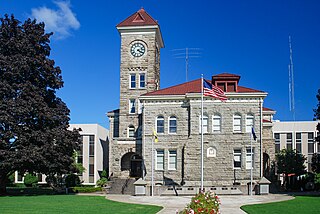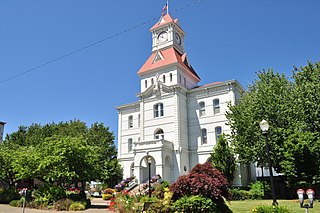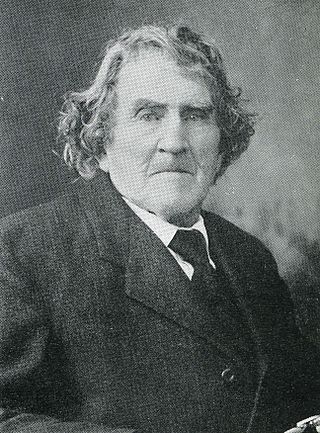
Salem is the capital city of the U.S. state of Oregon, and the county seat of Marion County. It is located in the center of the Willamette Valley alongside the Willamette River, which runs north through the city. The river forms the boundary between Marion and Polk counties, and the city neighborhood of West Salem is in Polk County. Salem was founded in 1842, became the capital of the Oregon Territory in 1851, and was incorporated in 1857.

Polk County is one of the 36 counties in the U.S. state of Oregon. As of the 2020 census, the population was 87,433. The county seat is Dallas. The county is named for James Knox Polk, the 11th president of the United States.

Marion County is one of the 36 counties in the U.S. state of Oregon. The population was 345,920 at the 2020 census, making it the 5th most populous county in Oregon. The county seat is Salem, which is also the state capital of Oregon. The county was originally named the Champooick District, after Champoeg, a meeting place on the Willamette River. On September 3, 1849, the territorial legislature renamed it in honor of Francis Marion, a Continental Army general from South Carolina who served in the American Revolutionary War. Marion County is part of the Salem, OR Metropolitan Statistical Area, which is also included in the Portland-Vancouver-Salem, OR-WA Combined Statistical Area. It is located in the Willamette Valley.

Benton County is one of the 36 counties in the U.S. state of Oregon. As of the 2023 census population estimates, the population was 99,355. Its county seat is Corvallis. The county was named after Thomas Hart Benton, a U.S. Senator who advocated American control over the Oregon Country. Benton County is designated as the Corvallis, OR Metropolitan Statistical Area, which is included in the Portland–Vancouver–Salem, OR–WA Combined Statistical Area. It is in the Willamette Valley.

Dallas is a city and the county seat of Polk County, Oregon, United States. The population was 16,854 at the 2020 census.

Willamette Valley is an American Viticultural Area (AVA) which lies in the Willamette Valley of Oregon. The AVA is the wine growing region which encompasses the drainage basin of the Willamette River. It stretches from the Columbia River in the north to just south of Eugene in the south, where the Willamette Valley ends; and from the Oregon Coast Range in the west to the Cascade Mountains in the east. At 5,360 square miles, it is the largest AVA in the state, and contains most of the state's wineries; approximately 908 as of 2021.

Jesse Applegate was an American pioneer who led a large group of settlers along the Oregon Trail to the Oregon Country. He was an influential member of the early government of Oregon, and helped establish the Applegate Trail as an alternative route to the Oregon Trail.

John Minto IV was an American pioneer born in Wylam, England. He was a prominent sheep farmer in the U.S. state of Oregon and a four-time Republican representative in the state legislature. Minto also volunteered for the militia during the Cayuse War and years later helped locate Minto and Santiam passes through the Cascade Mountains east of Salem, Oregon.

The Eola-Amity Hills AVA is an American Viticultural Area located in Polk and Yamhill Counties, Oregon. It is entirely within the Willamette Valley AVA, and stretches from the city of Amity in the north to Salem in the south. The Eola and Amity hills cover an area west of the Willamette River approximately 15 miles (24 km) long by 6 miles (10 km) wide. The Eola-Amity Hills area benefits from steady winds off the Pacific Ocean that reach the Willamette Valley through the Van Duzer Corridor, a gap in the Oregon Coast Range, moderating the summer temperatures. The Eola Hills were named after the community of Eola, whose name was derived from Aeolus, the Greek god of the winds.

Benjamin F. Hayden was an American attorney and politician in the state of Oregon. A native of Kentucky, he moved to the West Coast with the California Gold Rush in 1849 and to Oregon in 1852. A Democrat, he served in the Oregon House of Representatives, including the 1870 session as speaker of the body.

Zena, Oregon is a former community approximately 10 miles (16 km) northwest of Salem, Oregon, United States, in Polk County. The community was established in 1858, originally called "Spring Valley". It was renamed "Zena" by Daniel Jackson Cooper and his brother Jacob Calvin Cooper, pioneers from Missouri. In 1866, they built a store and located the post office there, renaming the community in tribute to their wives, ArvazenaSpilman Cooper and MelzenaSpilman Cooper. Zena is home to the historic Spring Valley Presbyterian Church. The 1992 novel, The Road to Zena by Joel Redon, is set in Zena and nearby Lincoln.

Benjamin Franklin Burch was an American farmer, soldier, and politician in what became the state of Oregon. A native of Missouri, he moved to the Oregon Country in 1845 and served in the Cayuse and Yakima wars. A Democrat, he represented Polk County at the Oregon Constitutional Convention, in the Oregon House of Representatives, and in the Oregon State Senate including one session as President of the Senate.
John Daniel Boon was an American merchant and politician in what became the state of Oregon. A native of Ohio, he immigrated to the Oregon Country where he farmed and later operated a general store. A Democrat, he served as the Treasurer of the Oregon Territory and was the first Oregon State Treasurer. His former home and store are both listed on the National Register of Historic Places.

Spring Valley is a valley in Polk County, Oregon, United States, situated north and east of the Eola Hills and west of the Willamette River. It corresponds roughly to the drainage of Spring Valley Creek. Populated places in Spring Valley include Zena and Lincoln. Oregon Route 221 passes along the east side of the valley, next to the Willamette River.

Ballston is an unincorporated community, in Polk County, Oregon, United States. It is southeast of Sheridan and southwest of Amity. It is considered a ghost town.

Levi Lindsey Rowland FRSE was an American educator and physician in the state of Oregon. A native of Tennessee, he served as the Oregon Superintendent of Public Instruction, president of what became Western Oregon University, and as the superintendent of Oregon's insane asylum, now the Oregon State Hospital. The Republican was also a pastor and farmer.

The Willamette Valley is a 150-mile (240 km) long valley in Oregon, in the Pacific Northwest region of the United States. The Willamette River flows the entire length of the valley and is surrounded by mountains on three sides: the Cascade Range to the east, the Oregon Coast Range to the west, and the Calapooya Mountains to the south.

The Valley and Siletz Railroad (VS) is a 40.6-mile (65.3 km) defunct railroad located in Polk and Benton counties in the U.S. state of Oregon.
Crowley is an unincorporated community in Polk County, Oregon, United States. It is located east of Oregon Route 99W, about four miles north of Rickreall.

John Turner was an American fur trapper and guide who first entered Oregon Country in 1828 and became an early resident of the Willamette Valley. Later he moved to California where he was part of the second attempt to rescue the Donner Party.





















